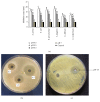Production, Characterization, and Antimicrobial Activity of Mycocin Produced by Debaryomyces hansenii DSMZ70238
- PMID: 28757872
- PMCID: PMC5512030
- DOI: 10.1155/2017/2605382
Production, Characterization, and Antimicrobial Activity of Mycocin Produced by Debaryomyces hansenii DSMZ70238
Abstract
The present study was conducted to estimate the antimicrobial activity and the potential biological control of the killer toxin produced by D. hansenii DSMZ70238 against several pathogenic microorganisms. In this study, the effects of NaCl, pH, and temperature, killer toxin production, and antimicrobial activity were studied. The results showed that the optimum inhibitory effect of killer toxin was at 8% NaCl, and the diameters of clear zones were 20, 22, 22, 21, 14, and 13 mm for Staphylococcus aureus, Escherichia coli, Klebsiella pneumoniae, Streptococcus pyogenes, Candida albicans, and Candida neoformans, respectively. The largest inhibition zones were observed at pH 4.5 with inhibition zone of 16, 18, 17, 18, 11, and 12 mm for the same microorganisms. The results also showed that 25°C is the optimal temperature for toxin killing activity against all targeted microorganisms. In addition, the activity of killer toxin significantly inhibited the growth of fungal mycelia for all target pathogenic fungi and the percentages of inhibition were 47.77, 48.88, 52.22, and 61.11% for Trichophyton rubrum, Alternaria alternata, Trichophyton concentricum, and Curvularia lunata, respectively. The results showed the highest growth rate of D. hansenii DSMZ70238 under condition of 8% NaCl concentration, pH 4.5, and 25°C for 72 h.
Figures






References
LinkOut - more resources
Full Text Sources
Other Literature Sources

